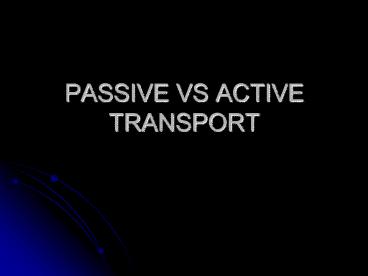PASSIVE VS ACTIVE TRANSPORT - PowerPoint PPT Presentation
Title:
PASSIVE VS ACTIVE TRANSPORT
Description:
PASSIVE VS ACTIVE TRANSPORT PASSIVE TRANSPORT Requires no energy input from the cell Goes WITH the concentration gradient Usually small, uncharged particles ACTIVE ... – PowerPoint PPT presentation
Number of Views:100
Avg rating:3.0/5.0
Title: PASSIVE VS ACTIVE TRANSPORT
1
PASSIVE VS ACTIVE TRANSPORT
2
PASSIVE TRANSPORT
- Requires no energy input from the cell
- Goes WITH the concentration gradient
- Usually small, uncharged particles
3
ACTIVE TRANSPORT
- -requires energy input from the cell
- -goes against the concentration gradient
- -large particles or charged particles
4
Types of Passive Transport
- Simple Diffusion
- Facilitated Diffusion
5
SIMPLE DIFFUSION
- Molecules that can pass directly through the
phospholipid layer of the cell membrane - Gases
- Water (OSMOSIS)
- Small, uncharged particles
6
FACILITATED DIFFUSION
- Molecules that need the assistance of a carrier
protein to enter a cell. - (large molecules)
- Glucose
7
OSMOSIS- diffusion of water
- HYPERTONIC SOLUTION
- -low concentration of water
- -high concentration of solutes
- -water flows out of the cell
- PLASMOLYSIS- cell shrivels
- HYPOTONIC SOLUTION
- -high concentration of water
- -low concentration of solutes
- -water flows into the cell
- CYTOLYSIS- cell bursts
8
ISOTONIC SOLUTION
- Balanced on both sides
9
Things that affect the rate of diffusion
- Temperature
- Pressure
- Size of molecules
- Size of openings in the cell membrane
10
Types of Active Transport
- 1 Solute Pumps- (charged items)
- 2 BULK TRANSPORT
- -EXOCYTOSIS
- -ENDOCYTOSIS
- PHAGOCYTOSIS
- PINOCYTOSIS
11
SOLUTE PUMPS
- Amino acids, some sugars, and most ions are
transported against the concentration gradient
12
SODIUM-POTASSIUM ION PUMP(PAGE 70)
- Needed for the transmission of impulses by nerve
cells. - 3 Sodium ions are pumped out of the cell and 2
Potassium ions are pumped in
13
SODIUM-POTASSIUM ION PUMP(PAGE 70)
- STEP 1- 3 sodium ions attach to carrier protein
which stimulates it to bind to Phosphate of ATP - STEP 2- Binding of Phosphate causes the protein
to change shape and expel the 3 sodium ions
outside and collect 2 potassium ions
14
SODIUM-POTASSIUM ION PUMP(PAGE 70)
- STEP 3- Loss of Phosphate causes the carrier
protein to return to original shape and Potassium
ions are released into the cell
15
BULK TRANSPORT
- Way to get substances into or out of the cell
that are too large for even a carrier protein - EXOCYTOSIS- large items exiting the cell via a
vesicle that fuses with the cell membrane
(usually from the Golgi apparatus)- hormones,
mucus, and cellular waste is secreted this way
16
ENDOCYTOSIS
- large items entering the cell via a vesicle that
is made by movement of the cell membrane - PINOCYTOSIS- cell drinking
- PHAGOCYTOSIS- cell eating-
17
PINOCYTOSIS- cell drinking
- When cell membrane comes in contact with
- liquid it folds in and forms a vesicle
18
PHAGOCYTOSIS- cell eating- example is White Blood
Cell
- STEP 1- cell comes in contact with food particle
- STEP 2- cell membrane creates pseudopods that
surround food - STEP 3- vesicle is formed and food enters the cell
19
RECEPTOR MEDIATED ENDOCYTOSIS- muscle cells
- Tiny receptors located on the cell membrane
- When a certain number of receptors is full then
the cell goes through endocytosis































